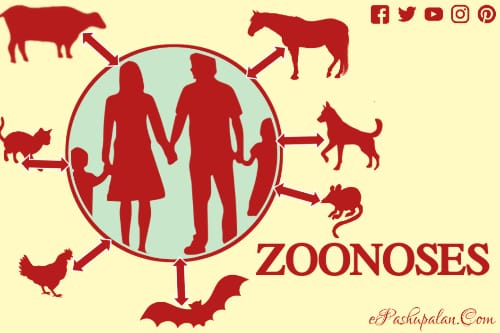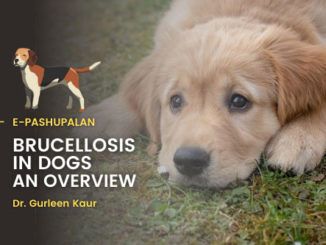DEFINITION
The word zoonoses came from a Greek word ‘ZOO’ means animal and ‘NOSOS’ means disease. It was first introduced by Rudolf Virchow in 1880 to include collectively the diseases shared in nature by man and animals. Later, the WHO in 1959 defined that Zoonoses are those diseases and infections which are naturally transmitted between vertebrate animals and man. Zoonoses include only those infections where there is either a proof or a strong circumstantial evidence for transmission between animals and man.

ZOONOSES – AN INTERNATIONAL CONCERN
Zoonotic diseases had a tremendous impact on the evolution of man, especially those cultures and societies that domesticated and bred animals for food and clothing. Zoonoses are among the most frequent and dreaded risk to which mankind is exposed. Zoonoses occurs throughout the world transcending the natural boundaries. Their important effect on global economy and health is well known, extending from the international movement if animals and important of diseases to ban on importation of all animal products and restrictions on other international trade practices
EMERGING PROBLEM
Over the last two decades, there has been considerable change in the importance of certain zoonotic disease in many parts of the world resulting from ecological changes such as urbanization, industrialization, and diminishing proportion of persons working in the primary sector. Among the zoonoses recognized today as particularly important are anthrax, plague, brucellosis, rabies, bovine tuberculosis, leptospirosis, salmonellosis, spotted fever caused by Rickettsia, several common arthropod borne viral infection (arboviral infection), certain parasitic disease like cysticercosis, hydatid disease, trypanosomiasis, and toxoplasmosis.
In general, the pathogenic species responsible for zoonotic disease can survive and multiply without the presence of man. In most cases, man acts as a dead end host and therefore not even useful for the perpetuation of the pathogenic agent. The only known exception to this rule are taenia solium and taenia saginata for which man is the unique definitive host. Agents of several genera (Balantidium, campylobacter, colibacilli, giardia, salmonella, sarcocystis) may infect both man and animals. Man may be infected by animals or even provide a mechanism for interhuman transmission. Almost all the zoonotic infection exist or occur only if the animals are present in the ecosystem.
How GERM DO spreads between animal and human group?
Direct contact: Coming into contact with saliva, blood, urine. Mucous, faeces, or other body fluids of an infected animal.
Indirect contact: Coming into contact with areas where animals live and roam or objects or surfaces that have been contaminated with germs. Examples include aquarium tank water, pet habitats chicken coops.
Vector borne: being bitten by a tick or an insect like a mosquito or a flea
Foodborne: eating or drinking something unsafe (such as unpasteurized milk, raw fruits and vegetable that are contaminated with faeces of affected animal )
Classification of zoonoses
According to the etiological agents
- Bacterial zoonoses: Anthrax, brucellosis, plague, leptospirosis, salmonellosis, lyme disease
- Viral zoonoses: Rabies, arbovirus infection, KFD, yellow fever, Influenza, CCHF
- Rickettsial zoonoses: Murine typhus, tick typhus , scrub typhus, Q
- Helminthic zoonoses: echinococcosis ( hydatid disease), taeniasis, Schistosomiasis, dranuncularis
- Protozoal zoonoses: Toxoplasmosis, trypanosomiasis, leishmaniasis
- Fungal zoonoses: Histoplasmosis cryptococcosis, superficial, dermatophytes
- Ectoparasites: Scabies, myiasis
According to the mode of transmission
- Direct zoonoses: These are transmitted from an infected host to a susceptible host (man) by direct contact, by contact with a fomite or by a mechanical vector. The agent itself undergoes little or no propagative or developmental changes during transmission. Examples are rabies, anthrax, brucellosis
- Cyclo-zoonoses: These require more than one vertebrate host species but no invertebrate host for the completion of life cycle of the agent. Examples are echinococcosois, Taeniasis
- Meta-zoonoses: These are transmitted biologically by invertebrate vectors, in which the agent multiplies and develops and there is always an extrinsic incubation period before transmission to another vertebrate host. Examples are plague, arbovirus infection, and schistosomiasis.
- Sapro-zoonoses: These require a vertebrate host and a non-animal developmental site like soil, material, pigeon dropping for the development of infectious agent. Examples are aspergillosis, coccidiomycosis, histoplasmosis
According to the reservoir host
- Anthropozoonoses: Infection transmitted to man from lower vertebrate animals. Eg. Rabies, leptospirosis, plague.
- Zooanthroponoses: Infection transmitted from man to lower vertebrate animal’s. Eg. Streptococci, staphylococci, diphtheria, human tuberculosis in cattle and parrots.
- Amphixenoses: Infection maintained in both man and lower vertebrate animals and transmitted in either direction eg. salmonellosis, staphylococci.
ONE HEALTH IN THE CONTEXT OF ZOONOSES
The One health initiative defines that one health as the collaborative efforts of multiple discipline working locally, nationally, and globally to attain optimal health for people, animals, plants and our environment. In the context of emerging zoonoses from wildlife, the disciplines that must work together are those of human and veterinary medicine. Emerging transboundary zoonoses require improved collaborative between these sectors to develop control strategies and implement surveillance and response activities at the animal human interface. But, just as importantly, to establish control strategies we must also consider the interactions of humans and animals with ecosystem and the environment
ZOONOSIS AS A PUBLIC HEALTH PROBLEM
Zoonotic diseases are a major public health problem in India. Approximately 20,000 death due to rabies are estimated to occur every year while more than 17 lakhs person bitten by suspected rabid animals seek anti rabies vaccination anti rabies treatment centers. Typhus killed many people during World War 1. Brucellosis alone is estimated to cause loss of Rs. 2400 lakhs through brucellosis in cattle and buffaloes. Japanese encephalitis is another emerging zoonotic disease in India causing several outbreaks and considerable morbidity and mortality. It is not surprising that 80% of population in India are from rural background and hence their association with animals will be close. Because of inadequate diagnostic facilities, unfamiliarity with physicians with these diseases and lack of coordination between physicians, and epidemiologist, the extent of their existence is obscured.






Be the first to comment